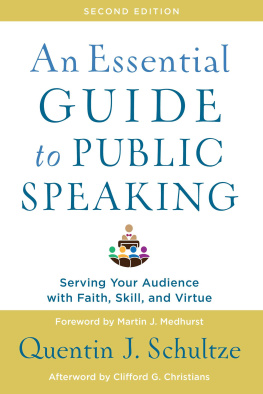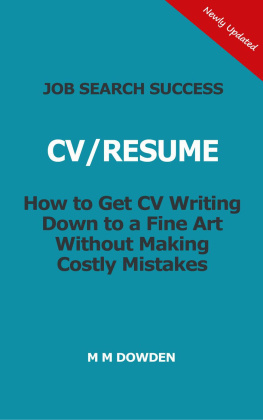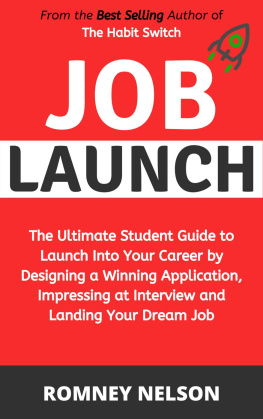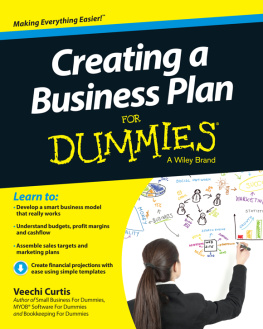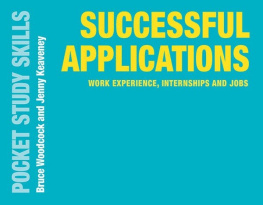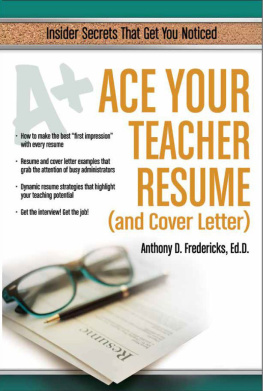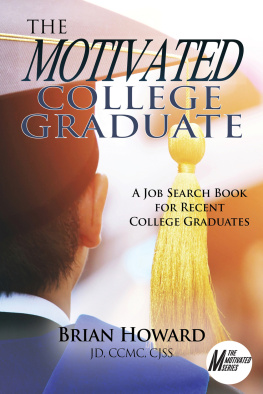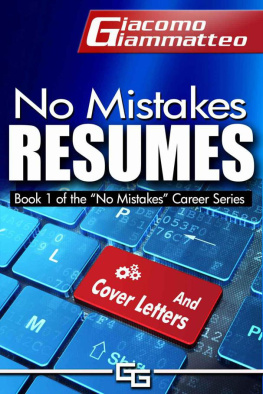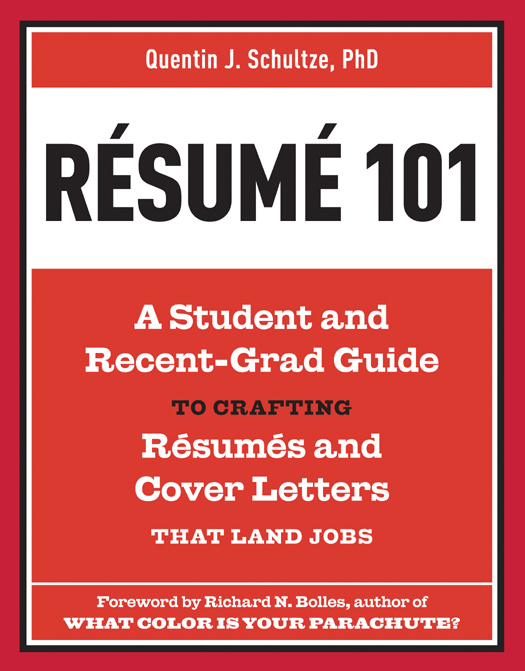Copyright 2010, 2012 by Quentin J. Schultze
Foreword copyright 2010 by Richard N. Bolles
All rights reserved.
Published in the United States by Ten Speed Press, an imprint of the Crown Publishing Group, a division of Random House, Inc., New York.
www.crownpublishing.com
www.tenspeed.com
Originally published in somewhat different form as How to Write Powerful College Student Rsums and Cover Letters by Edenridge Press, Grand Rapids, Michigan, in 2010.
Ten Speed Press and the Ten Speed Press colophon are registered trademarks of Random House, Inc.
Library of Congress Cataloging-in-Publication Data
Schultze, Quentin J. (Quentin James), 1952
Rsum 101 : a student and recent grad guide to crafting rsums and cover letters that land jobs / Quentin J. Schultze; foreword by Richard N. Bolles. 1st ed.
p. cm.
Originally published as How to Write Powerful College Student Rsums and Cover Letters by Edenridge Press, Grand Rapids, Michigan. Includes bibliographical references and index.
Summary: Communications professor Quentin Schultze shares the secrets to crafting strong, impressive rsums and cover letters for students and recent grads with minimal job experience Provided by publisher.
1. Rsums (Employment) 2. Cover letters. 3. College graduatesEmployment. I. Schultze, Quentin J. (Quentin James), 1952 How to write powerful college student rsums & cover letters. II. Title.
HF5383.S3275 2012
650.142dc23
2011035927
eISBN: 978-1-60774-195-4
v3.1
Contents
Acknowledgments
I AM GRATEFUL for hundreds of students at Calvin college who tested the principles in this book through their informational interviews, job applications, position interviews, and classroom feedback. I am also grateful for the many internship supervisors, career development experts, employers, professors, and human resource professionals who served the students and me.
One student who merits special words of thanks is Kimberly Webster. For her senior project, she conducted a survey of college and university career development offices and analyzed existing rsum-writing books in terms of how well they serve students.
Kim Chimienti reviewed, commented upon, and helped revise the entire manuscript. She also used the principles in this book to land a new job during dire economic timesbut thats a story to be told in a follow-up book on rsum writing for new career seekers.
The Works Cited section of this book lists the researchers and authors from whom I learned much about the different situations, careers, contexts, and strategies for rsum and cover-letter writing.
Matthew and Dawn Plescher served me as trusted colleagues on matters of style, content, and design ideas.
Richard N. Bolles, creator and author of the best-selling What Color Is Your Parachute?and not a big fan of rsum-writing books that overpromise and underdeliverinspired me to ensure that this book would truly serve college students and recent graduates.
My splendid editor, Lisa Westmoreland, nurtured the voice of the text while improving readability and enhancing the reader-serving content. Her confidence in me has been a great encouragement, and Im honored to have worked with her on this project.
Bethany J. Kim contributed many stylistic improvements, personal anecdotes, and contemporary examples. Her work improved the manuscript throughout.
Finally, I give thanks in advance for every person served by this book and for everyone else who served us along the way.
Quentin J. Schultze, PhD
Foreword
HERES A PUZZLE FOR YOU . Why are rsums so short, and books about how to write one so long? Why is a rsum two pages or less, while a rsum book is over two hundred pages, typically? Your first guess will probably be: because a rsum gets you a job, if you do it well, so you need detailed instructions about how to do it well. Good guess, but its wrong. A rsums purpose is not to get you a job; its simply to get you invited in for an interview at a place that interests you.
Okay then, your second guess might be: a rsum book has to be so long because youre essentially trying to sell yourself to an employer, and writing an effective sales piece takes a lot of time and talent to get it right. Thats another good guess, but it is, again, wrong. In a sales piece, you would put in as much information as possible to help would-be employers see what a splendid catch you would be. A good sales piece can run several pages. But in a rsum you leave out as much as possible, because the employer is reading your rsum to see if theres any excuse for screening you out. Put in one or two sentences too many, or mention something that you think might eventually sell you but is misinterpreted on a piece of paper that an employer spends about eight seconds scanning (typically), and youre toast.
All right, then, why does a solid rsum book have to be so long? To end the guessing game, Ill tell you the answer: Its because this isnt just a book about how to write a rsum. Its more than that. Its a book about how to look at yourself, how to take inventory of yourself, how to figure out whats absolutely special about you so you can gain more confidence, overcome shyness, and approach any employer, not as a job-beggar, but as a prize, a treasure, who will help the employer more than anyone else could. Thats why a rsum is so short, but a rsum book is so long.
Youll wonder, of course, why this rsum book? There are dozens and dozens of them out there. Whats so special about this one? Well, Ill tell you a story. I am myself an author; Ive written a book that ten million people have bought. (The average book sells only five thousand to twenty thousand copies.) My book is a job-hunting book. You know what makes my book so popular? Before I began, I went and read every single book about job-hunting that was out there. So my book, once I wrote it, gave a job-hunter a whole bunch of books, all wrapped up in one.
This rsum book that youre holding in your hand has an author who did exactly the same thing. He went and read every rsum book he could lay his hands on before he sat down to write this one. Thats not merely unusual; thats extraordinary. I have never read a rsum book whose author did that. Until now. Youve got a hundred books in one, here. I know all those other rsum books. So I read this one all the way through, page by page, to see if the author left out anything important. He didnt. Or if he said anything I strongly disagreed with. He didnt. Or if his book was too difficult for a college student to understand. It isnt. He touched all the right bases. This book is a home run.
Richard N. Bolles, author of What Color Is Your Parachute? A Practical Manual for Job-Hunters and Career-Changers (revised and updated annually)
Introduction
Why This Book Will Help You Land Interviews and Jobs
EMILY SHOWED UP AT MY CAMPUS OFFICE . She sheepishly stuck her head in the doorway and whispered, Dr. Schultze?
Hi, I replied.
Im Emily, she responded as we shook hands.
I could tell that Emily lacked self-confidence and probably had to overcome her own anxiety about going to see a professor she had never met.
How may I serve you? I asked.
EMILYS STORY MAY WELL BE YOUR STORY
Emily was a fourth-year college student who had gone through three different majorsnursing, business, and artand was searching for a new major that would make her more marketable after graduation. Feeling pressure from parents and friends, and worried about her future, she hoped that I could help her chart a career course. To her, the future meant a real job with health benefits and enough income to pay back her college loans and free her from parental support. Emilys anxiety was obvious in her shaky voice.


